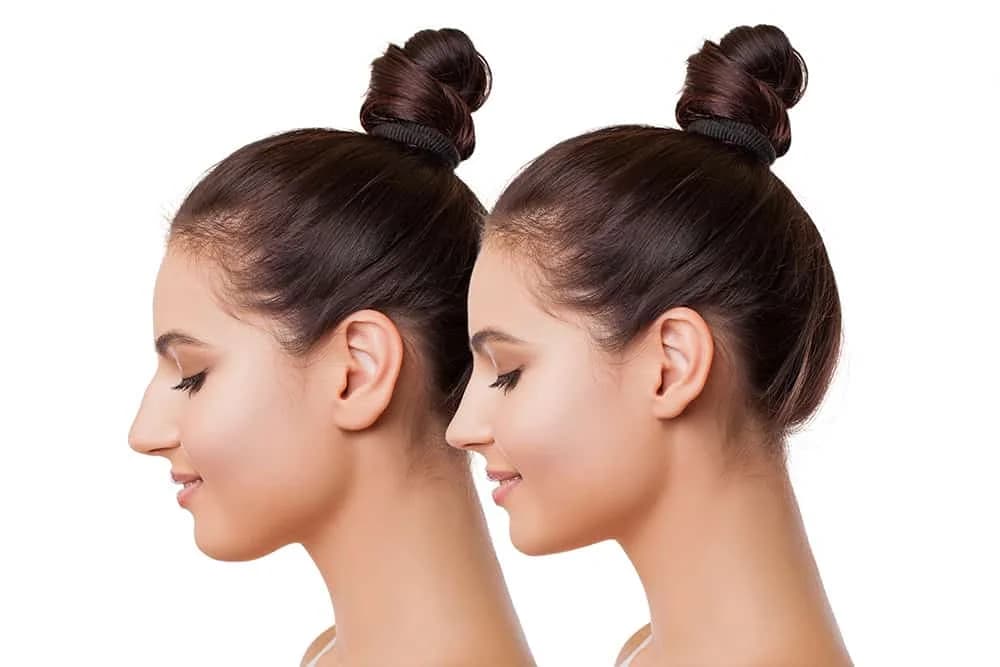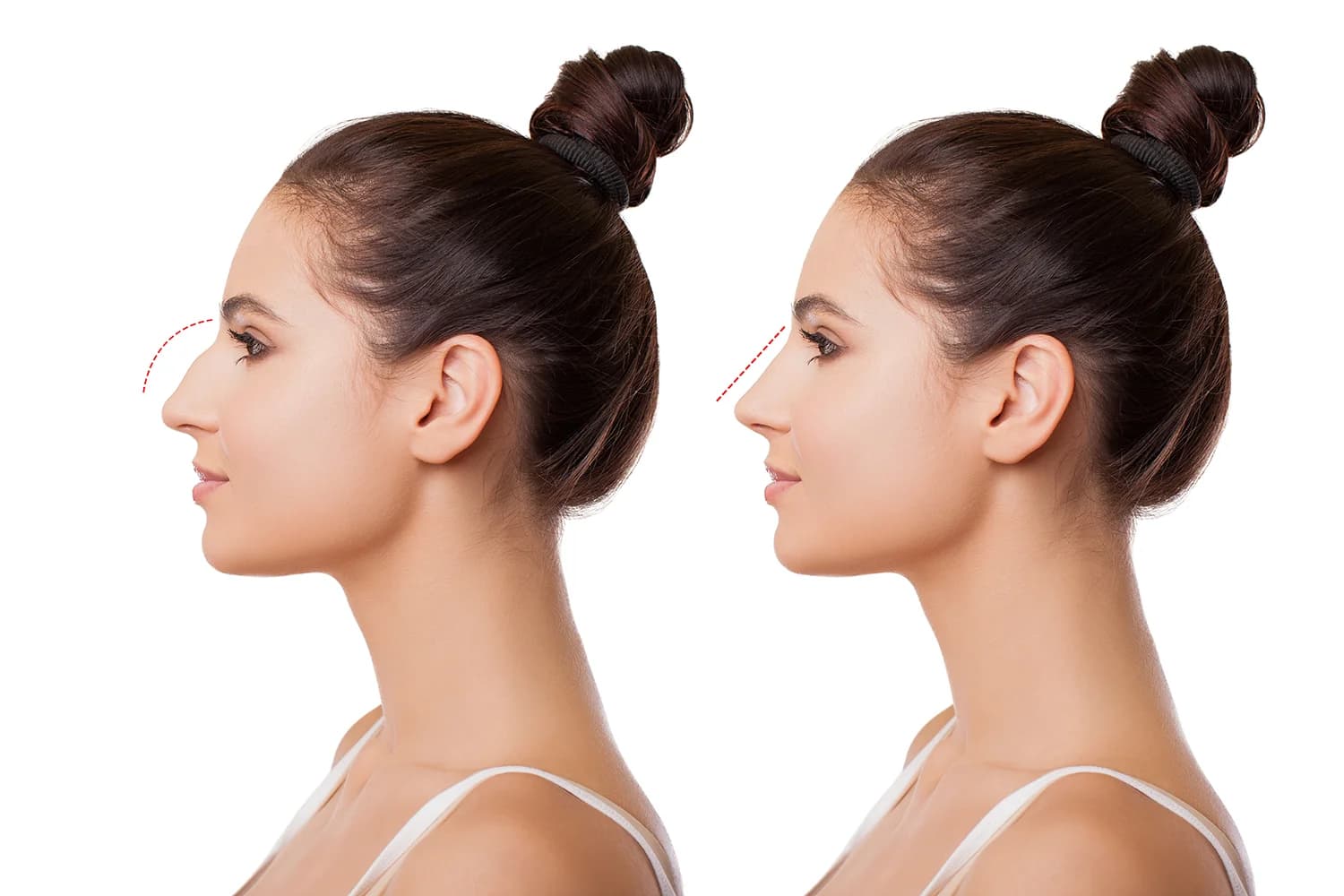Commonly known as a nose job, rhinoplasty is often used to correct impaired breathing that has been caused by issues with the structure of the nose. Reasons people choose a nose job include trauma, seeking a natural size or shape, or a more smoothly looking nose.
What Are the Different Types of Nose Jobs?
There are quite a few options when it comes to planning your rhinoplasty surgery. The main methods include:
Reduction rhinoplasty
Augmentation rhinoplasty
Post-traumatic rhinoplasty
Reconstructive rhinoplasty
Refinement rhinoplasty
Revision rhinoplasty
The type of nose job that you choose will be dependent on your reasons for having the surgery and your individual goals and expectations, as each method aims to tackle specific issues.

Reduction Rhinoplasty
As the name suggests, a reduction rhinoplasty is done to reduce the size of your nose. This can be done by bringing down the overall size of your nose or by focusing on specific features. A reduction nose job can narrow the width of your nostrils or reduce the size of the bumps on the bridge of your nose. It is usually achieved by removing small amounts of cartilage or bone to bring the nose in proportion with the rest of your facial features.
Augmentation Rhinoplasty
An augmentation rhinoplasty is the right choice for those who want to make changes to the shape of some of their nose’s features. This type of nose job aims to adjust the shape of these features by using a bone or tissue grafting technique to build up either the nasal tip or the bridge. In most cases, grafting is performed using cartilage from other parts of your nose.
Post-Traumatic Rhinoplasty
As the name suggests, this type of rhinoplasty is for patients who’ve damaged their nose. This surgery aims to tackle both aesthetic and functionality issues following an injury. Most commonly, patients who have post-traumatic rhinoplasty have broken their nose. Generally, a post-traumatic rhinoplasty involves the re-fracturing and then re-setting of your nose.

Refinement Rhinoplasty
Usually, patients wishing to change the shape of their nasal tip, undergo a refinement rhinoplasty. Whether it be the degree to which it points up or down, or the roundness or pointiness of it, a refinement rhinoplasty aims to tackle this prominent part of the nose. While for some, fat tissue is removed or repositioned, for others implants may be inserted to reshape the tip of the nose.
Reconstructive Rhinoplasty
Unlike most types of nose jobs, a reconstructive rhinoplasty can be suitable for more serious medical cases. It is a specialist technique that aims to restore damaged or lost tissue following illness or injury. During this surgery, the surgeon rebuilds the nose using skin grafts from other parts of the body to replace the damaged or lost tissue.
Revision Rhinoplasty
Our final type of nose job is what’s known as a revision rhinoplasty. This technique is used to revise a previously carried out nose surgery. Patients may request a revision rhinoplasty because they are unsatisfied with the appearance or functionality of the nose from a previous surgery.

Which Rhinoplasty Is Right for You?
The right type of rhinoplasty for you depends on your unique nasal structure, aesthetic goals, and any breathing issues you may have. There are several types of rhinoplasty procedures. These are:
Open rhinoplasty: Involves an incision along the columella, the strip of tissue that separates the nostrils, providing the surgeon with direct visibility and access to the underlying structures. This method is typically used for more complex surgeries, such as major reshaping or reconstruction.
Closed rhinoplasty: Involves incisions made within the nostrils, leaving no visible scars. It’s generally used for simpler procedures that require minor adjustments to the nasal structures.
Revision rhinoplasty: Performed to correct issues from a previous nose surgery. This can be more complex due to the changes already made to the nasal structure and potential scar tissue.
Functional rhinoplasty: Aims at correcting breathing problems due to a deviated septum or other internal nose structure issues. This can often be combined with cosmetic changes.
Non-surgical rhinoplasty: This uses injectable fillers to alter the shape of the nose. This is a temporary solution and is less invasive, but it’s limited in the changes that can be made.
Choosing the right type of rhinoplasty depends on several factors. If you’re seeking a major change in size or shape, an open rhinoplasty may be the best option. For minor adjustments, a closed or non-surgical procedure might suffice. If you’re experiencing breathing issues, a functional rhinoplasty could be necessary. By understanding the different types of procedures and considering your own needs and goals, you can make an informed decision about which type of rhinoplasty is right for you.
Rhinoplasty Recovery
Rhinoplasty is typically performed as an outpatient procedure using general anesthesia, although local anesthesia with intravenous sedation may be appropriate in certain cases. Your surgeon may place your new nose in a splint to protect it from accidental contact. Packing is typically removed within the first week after rhinoplasty. Your cosmetic surgeon will prescribe pain medication to help minimize discomfort during your initial recovery.
Conclusion
In conclusion, the type of nose job, or rhinoplasty, that is right for an individual depends on their unique needs and goals. From open and closed rhinoplasty to revision and functional rhinoplasty, each procedure offers different benefits and is suited to different circumstances. Non-surgical rhinoplasty provides a less invasive alternative for minor adjustments. Ultimately, the decision should be made in consultation with a skilled, board-certified plastic surgeon who can provide personalized advice based on a thorough assessment. Despite the complexity of the decision, with the right guidance, individuals can confidently choose the type of rhinoplasty that will help them achieve their desired outcomes.
Read more: